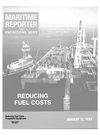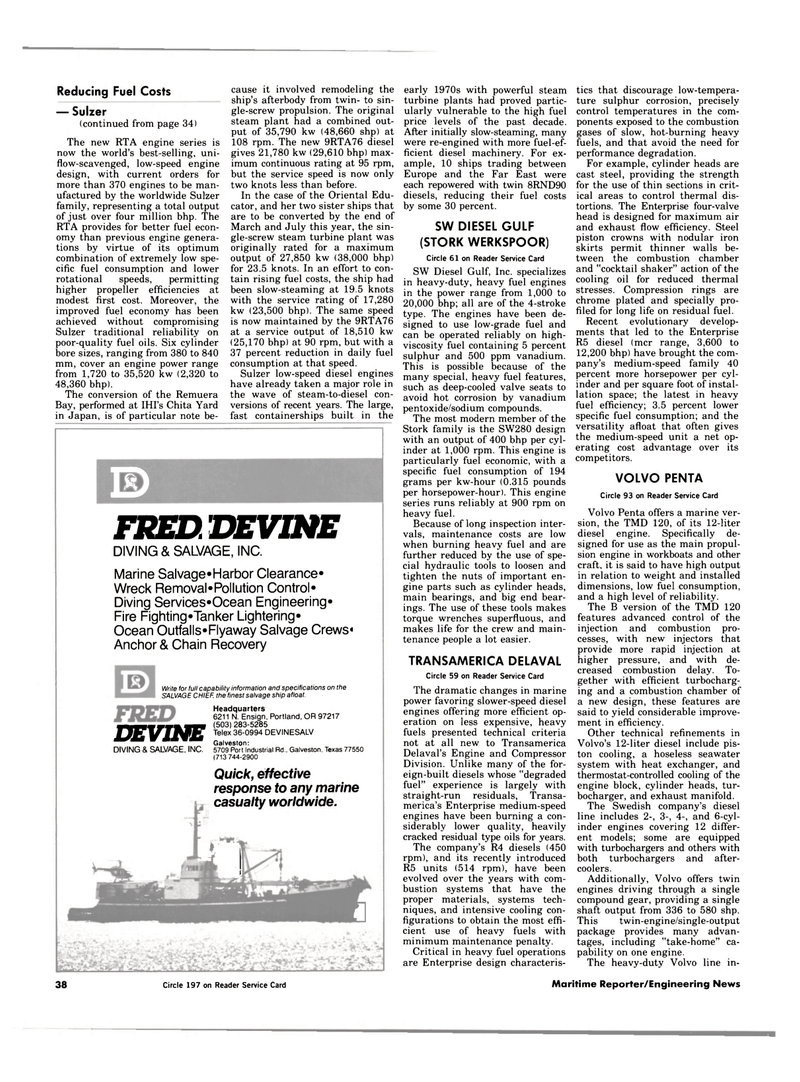
Page 36: of Maritime Reporter Magazine (January 15, 1984)
Read this page in Pdf, Flash or Html5 edition of January 15, 1984 Maritime Reporter Magazine
Reducing Fuel Costs — Sulzer (continued from page 34)
The new RTA engine series is now the world's best-selling, uni- flow-scavenged, low-speed engine design, with current orders for more than 370 engines to be man- ufactured by the worldwide Sulzer family, representing a total output of just over four million bhp. The
RTA provides for better fuel econ- omy than previous engine genera- tions by virtue of its optimum combination of extremely low spe- cific fuel consumption and lower rotational speeds, permitting higher propeller efficiencies at modest first cost. Moreover, the improved fuel economy has been achieved without compromising
Sulzer traditional reliability on poor-quality fuel oils. Six cylinder bore sizes, ranging from 380 to 840 mm, cover an engine power range from 1,720 to 35,520 kw (2,320 to 48,360 bhp).
The conversion of the Remuera
Bay, performed at IHI's Chita Yard in Japan, is of particular note be- cause it involved remodeling the ship's afterbody from twin- to sin- gle-screw propulsion. The original steam plant had a combined out- put of 35,790 kw (48,660 shp) at 108 rpm. The new 9RTA76 diesel gives 21,780 kw (29,610 bhp) max- imum continuous rating at 95 rpm, but the service speed is now only two knots less than before.
In the case of the Oriental Edu- cator, and her two sister ships that are to be converted by the end of
March and July this year, the sin- gle-screw steam turbine plant was originally rated for a maximum output of 27,850 kw (38,000 bhp) for 23.5 knots. In an effort to con- tain rising fuel costs, the ship had been slow-steaming at 19.5 knots with the service rating of 17,280 kw (23,500 bhp). The same speed is now maintained by the 9RTA76 at a service output of 18,510 kw (25,170 bhp) at 90 rpm, but with a 37 percent reduction in daily fuel consumption at that speed.
Sulzer low-speed diesel engines have already taken a major role in the wave of steam-to-diesel con- versions of recent years. The large, fast containerships built in the
E)
FRED DEVINE
DIVING & SALVAGE, INC.
Marine Salvage*Harbor Clearance-
Wreck Removal-Pollution Control-
Diving Services-Ocean Engineering-
Fire Fighting-Tanker Lightering-
Ocean Outfalls-Flyaway Salvage Crews*
Anchor & Chain Recovery
Write for full capability information and specifications on the
SALVAGE CHIEF the finest salvage ship afloat.
DEVINE
DIVING & SALVAGE, INC.
Headquarters 6211 N. Ensign, Portland, OR 97217 (503)283-5285
Telex 36-0994 DEVINESALV
Galveston: 5709 Port Industrial Rd.. Galveston. Texas 77550 (713 744-2900
Quick, effective response to any marine casualty worldwide. 11 '96 4 early 1970s with powerful steam turbine plants had proved partic- ularly vulnerable to the high fuel price levels of the past decade.
After initially slow-steaming, many were re-engined with more fuel-ef- ficient diesel machinery. For ex- ample, 10 ships trading between
Europe and the Far East were each repowered with twin 8RND90 diesels, reducing their fuel costs by some 30 percent.
SW DIESEL GULF (STORK WERKSPOOR)
Circle 61 on Reader Service Card
SW Diesel Gulf, Inc. specializes in heavy-duty, heavy fuel engines in the power range from 1,000 to 20,000 bhp; all are of the 4-stroke type. The engines have been de- signed to use low-grade fuel and can be operated reliably on high- viscosity fuel containing 5 percent sulphur and 500 ppm vanadium.
This is possible because of the many special, heavy fuel features, such as deep-cooled valve seats to avoid hot corrosion by vanadium pentoxide/sodium compounds.
The most modern member of the
Stork family is the SW280 design with an output of 400 bhp per cyl- inder at 1,000 rpm. This engine is particularly fuel economic, with a specific fuel consumption of 194 grams per kw-hour (0.315 pounds per horsepower-hour). This engine series runs reliably at 900 rpm on heavy fuel.
Because of long inspection inter- vals, maintenance costs are low when burning heavy fuel and are further reduced by the use of spe- cial hydraulic tools to loosen and tighten the nuts of important en- gine parts such as cylinder heads, main bearings, and big end bear- ings. The use of these tools makes torque wrenches superfluous, and makes life for the crew and main- tenance people a lot easier.
TRANSAMERICA DELAVAL
Circle 59 on Reader Service Card
The dramatic changes in marine power favoring slower-speed diesel engines offering more efficient op- eration on less expensive, heavy fuels presented technical criteria not at all new to Transamerica
Delaval's Engine and Compressor
Division. Unlike many of the for- eign-built diesels whose "degraded fuel" experience is largely with straight-run residuals, Transa- merica's Enterprise medium-speed engines have been burning a con- siderably lower quality, heavily cracked residual type oils for years.
The company's R4 diesels (450 rpm), and its recently introduced
R5 units (514 rpm), have been evolved over the years with com- bustion systems that have the proper materials, systems tech- niques, and intensive cooling con- figurations to obtain the most effi- cient use of heavy fuels with minimum maintenance penalty.
Critical in heavy fuel operations are Enterprise design characteris- tics that discourage low-tempera- ture sulphur corrosion, precisely control temperatures in the com- ponents exposed to the combustion gases of slow, hot-burning heavy fuels, and that avoid the need for performance degradation.
For example, cylinder heads are cast steel, providing the strength for the use of thin sections in crit- ical areas to control thermal dis- tortions. The Enterprise four-valve head is designed for maximum air and exhaust flow efficiency. Steel piston crowns with nodular iron skirts permit thinner walls be- tween the combustion chamber and "cocktail shaker" action of the cooling oil for reduced thermal stresses. Compression rings are chrome plated and specially pro- filed for long life on residual fuel.
Recent evolutionary develop- ments that led to the Enterprise
R5 diesel (mcr range, 3,600 to 12,200 bhp) have brought the com- pany's medium-speed family 40 percent more horsepower per cyl- inder and per square foot of instal- lation space; the latest in heavy fuel efficiency; 3.5 percent lower specific fuel consumption; and the versatility afloat that often gives the medium-speed unit a net op- erating cost advantage over its competitors.
VOLVO PENTA
Circle 93 on Reader Service Card
Volvo Penta offers a marine ver- sion, the TMD 120, of its 12-liter diesel engine. Specifically de- signed for use as the main propul- sion engine in workboats and other craft, it is said to have high output in relation to weight and installed dimensions, low fuel consumption, and a high level of reliability.
The B version of the TMD 120 features advanced control of the injection and combustion pro- cesses, with new injectors that provide more rapid injection at higher pressure, and with de- creased combustion delay. To- gether with efficient turbocharg- ing and a combustion chamber of a new design, these features are said to yield considerable improve- ment in efficiency.
Other technical refinements in
Volvo's 12-liter diesel include pis- ton cooling, a hoseless seawater system with heat exchanger, and thermostat-controlled cooling of the engine block, cylinder heads, tur- bocharger, and exhaust manifold.
The Swedish company's diesel line includes 2-, 3-, 4-, and 6-cyl- inder engines covering 12 differ- ent models; some are equipped with turbochargers and others with both turbochargers and after- coolers.
Additionally, Volvo offers twin engines driving through a single compound gear, providing a single shaft output from 336 to 580 shp.
This twin-engine/single-output package provides many advan- tages, including "take-home" ca- pability on one engine.
The heavy-duty Volvo line in- 38 Circle 197 on Reader Service Card Maritime Reporter/Engineering News

 35
35

 37
37
